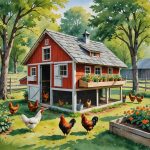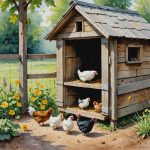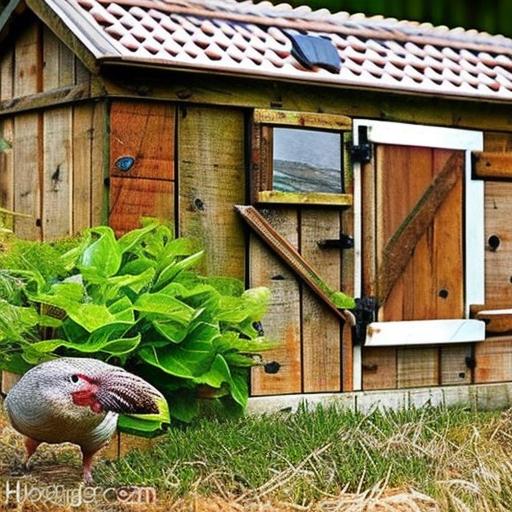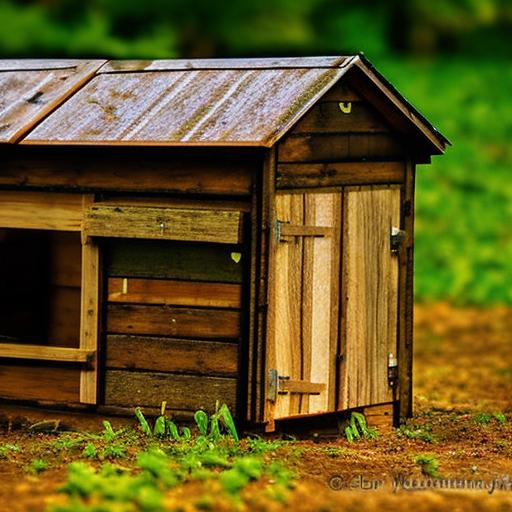Tucked away in the corner of a bustling farmyard, the humble chicken coop stands as a beacon of shelter for its feathered inhabitants. Drawing a chicken coop may seem like a simple task, but capturing the essence of this rustic structure requires attention to detail and a touch of creativity. Whether you’re an aspiring artist or just looking to add a dash of charm to your next sketch, follow along as we explore the tips and techniques for bringing a chicken coop to life on paper.
Table of Contents
Visualizing Your Chicken Coop Design
Creating a visual portrayal of your chicken coop design is essential for both planning and building purposes. To draw a chicken coop effectively,follow these steps:
- Gather Supplies: Grab a pencil,eraser,ruler,and paper or drawing software.
- Measurements: Determine the dimensions of your coop and sketch out the layout.
- Details: Add in specific features such as nesting boxes, perches, and doors.
allows you to see how everything will fit together and make any necessary adjustments before construction begins. By following these simple steps, you can create a detailed drawing that will guide you through the building process.
Choosing the Right Materials for Construction
When it comes to constructing a chicken coop, choosing the right materials is essential for ensuring the safety and comfort of your feathered friends. Durability should be at the top of your list when selecting materials, as a well-built chicken coop can last for many years. Consider using pressure-treated wood for the frame and walls, as it is indeed resistant to rot and decay. Additionally, galvanized hardware such as nails and screws can withstand the elements and prevent rusting.
Insulation is another vital factor to consider when choosing materials for your chicken coop. Proper insulation can help regulate the temperature inside the coop, keeping it warm in the winter and cool in the summer. Straw bales can be used to insulate the walls, while shingles on the roof can help keep out moisture and prevent leaks.
Ensuring Proper Ventilation and lighting
Proper ventilation and lighting are crucial for maintaining a healthy habitat for your chickens in their coop.Without adequate airflow, ammonia from droppings can build up, leading to respiratory issues. Additionally,good lighting is essential for the chickens’ overall well-being and productivity. Here are some tips on how to ensure proper ventilation and lighting in your chicken coop:
Airflow:
- Install vents at the top and bottom of the coop to allow for cross ventilation.
- Use windows or vents with wire mesh to keep out predators while still allowing air to flow.
- Regularly clean out bedding and droppings to prevent ammonia buildup.
Lighting:
- Provide natural light by positioning windows or skylights in the coop.
- Install artificial lighting on a timer to ensure a consistent day-night cycle for the chickens.
- ensure that there are no dark corners in the coop where predators could hide.
Adding Final Touches for Functional and Aesthetic Appeal
To truly make your chicken coop stand out,consider adding some final touches that not only enhance its functionality but also elevate its aesthetic appeal. One way to do this is by incorporating decorative elements such as colorful patterns or artistic designs on the exterior walls of the coop. This can make the structure more visually appealing and add a touch of personality to your backyard.
In addition to enhancing the visual appeal of your chicken coop, you can also focus on adding functional elements that improve its overall performance. Consider installing a weatherproof roof to protect your feathered friends from the elements, or adding a ventilation system to ensure proper air circulation inside the coop. these small but important details can make a big difference in the comfort and well-being of your chickens. Don’t forget to also add some finishing touches like a sturdy gate or a cozy nesting box to make your coop both functional and stylish.
Q&A
Q: Why should I learn how to draw a chicken coop?
A: Drawing a chicken coop can be a fun and creative exercise that allows you to practice your art skills while also learning more about the structure and design of a common farm building.
Q: What materials do I need to draw a chicken coop?
A: To draw a chicken coop, you will need paper, pencils, erasers, and perhaps some colored pencils or markers if you want to add some extra detail and flair to your drawing.
Q: What are some key features of a chicken coop that I should include in my drawing?
A: Some key features to include in your chicken coop drawing are the main structure of the coop, the nesting boxes, the roosting bars, and any doors or windows. You may also want to include details such as a ramp for the chickens to enter and exit the coop, and any decorative elements such as a weather vane or hanging plants.
Q: Are there any tips for drawing a realistic chicken coop?
A: To draw a realistic chicken coop, pay attention to the proportions of the various elements and ensure that the overall shape and design make sense for housing chickens. You may also want to research different types of chicken coops to get ideas for different styles and layouts.
Q: Can I personalize my chicken coop drawing?
A: Absolutely! Feel free to get creative and add your own personal touches to your chicken coop drawing, such as adding unique architectural details, painting it in your favourite colors, or even adding some cartoon chickens pecking around the coop.
Q: What are some resources for learning more about drawing chicken coops?
A: You can find inspiration for your chicken coop drawing by looking at pictures of real chicken coops online or in books, watching tutorials on drawing structures and buildings, or even taking a trip to a local farm to observe actual chicken coops in person.
to sum up
As you practice the art of drawing chicken coops, remember to have fun and let your creativity flow. With each stroke of your pencil, imagine the bustling sounds of clucking hens and the warmth of a cozy nest inside. Whether you’re a seasoned artist or a beginner, embrace the challenge of capturing the charm and character of a humble chicken coop on paper. So grab your sketchbook and pencil, and let your creativity take flight in creating your very own masterpiece.Happy drawing!
Meet Walter, the feathered-friend fanatic of Florida! Nestled in the sunshine state, Walter struts through life with his feathered companions, clucking his way to happiness. With a coop that’s fancier than a five-star hotel, he’s the Don Juan of the chicken world. When he’s not teaching his hens to do the cha-cha, you’ll find him in a heated debate with his prized rooster, Sir Clucks-a-Lot. Walter’s poultry passion is no yolk; he’s the sunny-side-up guy you never knew you needed in your flock of friends!






